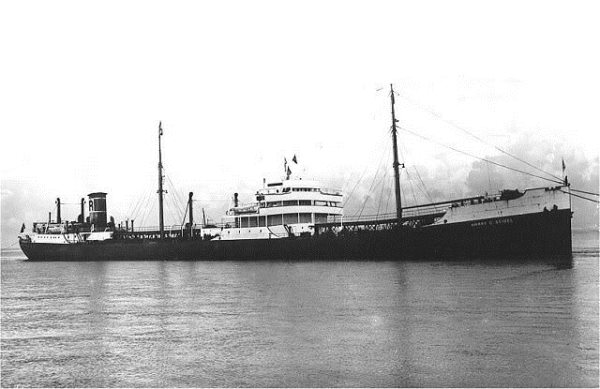Harry G. Seidel
Panamanian Motor tanker

| Name | Harry G. Seidel | ||
| Type: | Motor tanker | ||
| Tonnage | 10,354 tons | ||
| Completed | 1930 - Friedrich Krupp Germaniawerft AG, Kiel | ||
| Owner | Panama Transport Co (Standard Oil Co), Panama | ||
| Homeport | Panama | ||
| Date of attack | 29 Apr 1942 | Nationality: | |
| Fate | Sunk by U-66 (Richard Zapp) | ||
| Position | 11° 50'N, 62° 50'W - Grid ED 8696 | ||
| Complement | 50 (2 dead and 48 survivors). | ||
| Convoy | |||
| Route | Aruba (27 Apr) - Caripito, Venezuela | ||
| Cargo | Ballast | ||
| History | Completed in October 1930 for Baltisch-Amerikanische Petroleum Import GmbH, Danzig. 1935 transferred to Panama Transport Co, Panama. | ||
| Notes on event | At 04.12 hours on 29 April 1942 the unescorted Harry G. Seidel (Master Magnus Jorgensen) was hit on the port side by two torpedoes from U-66 while steaming on a non-evasive course at 11 knots about 12 miles northeast of Los Testigos Islands. The torpedo tracks were seen in the bright moonlight about 100 yards away, too late to take avoiding actions and the first struck the bunker just ahead of the engine room and the second hit the boiler room. The explosions stopped the engines, disabled the wireless station and destroyed the area on port side aft completely. The flooding of the engine room caused the tanker to settle by the stern with a heavy list to port. 44 crew members and six armed guards (the ship was armed with one 4in and two machine guns) began to abandon ship in three lifeboats in fine weather and calm seas, but two crewmen had been too badly injured to be moved off and had to be left behind. The boat on port side aft had been destroyed, so all 28 men aft left in the boat on the starboard side. The master left in the other starboard lifeboat with ten men and proceeded with the other boats to pick up the chief engineer and six others who had jumped overboard. The U-boat surfaced about 20 minutes after the attack to sink the Harry G. Seidel with gunfire, however she sank rapidly by the stern before fire was opened. The Germans then questioned the survivors, asking for the name and tonnage and if they needed anything. They left the area after the master answered the questions and declined their offer. The occupants were divided equally among the three lifeboats which then set sail for the Venezuelan coast, about 60 miles away. One of the boats was equipped with an outboard motor and took the other boats in tow when the wind died at dawn and the emergency wireless transmitter was used to send a distress signal, but no reply was received. The survivors made landfall in the Bay of Caribes after 21 hours and were assisted by natives until the next day when they were led by a police officer over mountains and through jungles to a motor launch that took them to the village of Rio Caribes. The British authorities at Trinidad had sent a small tug and a yacht to pick them up and they were landed at Port of Spain on 1 May. A week later the 42 crew members sailed on the American steam passenger ship George Washington to New York, arriving on 21 May. | ||
| On board | We have details of 50 people who were on board. | ||
If you can help us with any additional information on this vessel then please contact us.
